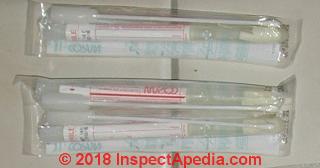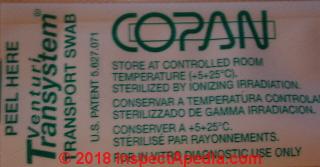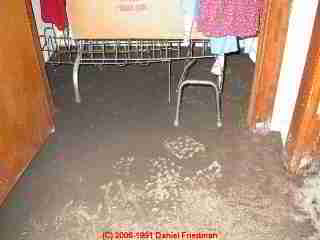 Sterile Swab Test Kits
Sterile Swab Test Kits
How & when to use a swab test kit
- POST a QUESTION or COMMENT about testing for environmental contaminants using sterile swab test kits
Sterile swab test kits:
Here we explain the steps in using a sterile swab to test a building surface for evidence of sewage contamination or for other purposes such as collecting surface contents to screen for pesticide application, mold (questionable) or other indoor contaminants.
Page top photo: sewage debris remnants on a concrete floor after a sewage backup in a New York home. Testing to confirm this condition is not necessary, but swab testing might be used after the sewage cleanup-job to confirm that the cleaning and sanitation steps were adequate.
This article series explains how to deal with and test for various types of environmental contamination in and around buildings.
InspectAPedia tolerates no conflicts of interest. We have no relationship with advertisers, products, or services discussed at this website.
- Daniel Friedman, Publisher/Editor/Author - See WHO ARE WE?
Sterile Swab Test Procedures
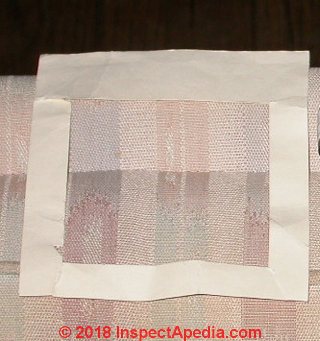 Typical sampling methods to test for sewage contamination in buildings and some other forensic or environmental tests such as the collection of material to test for pesticide or mold, include use of sterile swabs on sample surfaces both in the suspected area and as a control in other building areas where low or no contamination is expected.
Typical sampling methods to test for sewage contamination in buildings and some other forensic or environmental tests such as the collection of material to test for pesticide or mold, include use of sterile swabs on sample surfaces both in the suspected area and as a control in other building areas where low or no contamination is expected.
In our photo is a cardboard rectangle used to guide the size of sample area for surface particle tests. Such a paper rectangle can be suitable for use in marking off an area to be tested using a sterile swab.
Sampling templates are sold in two sizes: 4 x 5cm (20cm2) and 10 x 10cm (100cm2). For sterile swab sampling you will probably want to use the 100 cm2 size.
Step by step details of how sterile swabs are used to collect environmental samples of suspected mold, sewage, pesticide residue, or other substances are found here.
- Choose the test surface: A rectangular area of about 10 x 10 cm (4 sq. in.) is marked or selected in a representative area of surface to be tested for sewage contamination.
Some sterile swab tests kits include a heavy paper square with a rectangular 10 x10 cm cutout in its center to permit very precise area measurements for this test . - Wearing appropriate protective clothing for working in a sewage contamination area (booties, coveralls, respirator, eye protection, sterile gloves) or in other hazardous areas such as a badly-contaminated moldy building.
- Choose the sterile swab test kit: a sterile swab is used to swab the test area.
Below: Copan sterile swabs used by the author for surface sampling for bacterial contamination such as proof of adequate clean-up after a sewage contamination problem in a building.
- Wipe the swab on the test surface: The swab is wiped sequentially across the test area using light pressure in a series of straight lines to cover the test area. I rotate the swab during this procedure so that all of its surface has been in contact with the test area as I move through it.
- Save the swab: The dampened swab is inserted back into the sterile tube, obviously with the swab-end going first, down into the tube.
- Label the swab sample: The swab container is then sealed and labelled.
- Use a chain of custody document: Log the sample in to your chain of custody sheet. Include the property address, date, time, location of the sample, size of the area swabbed, and your contact information.
The information chain of custody serves more than to provide legal documentation of your test sample. It also provides information needed by the environmental test laboratory who will process your sample. - Mail the sewage contamination test swab kit to a test laboratory equipped to process the swab to identify the bacterial pathogens it has collected. Be sure to indicate to the test laboratory the tests that you want wanted.
Many water test labs can provide this service. For sewage contamination tests that might include
E. Coli and/or Enterococcus, Fecal Coliforms, and Total Coliforms.
Enterococcus is a good sewage contamination indicator since it indicates fecal waste from humans or other animals. However Enterococcus can also derive from some plants.
It is important that you do not simply have a lab test for total coliforms since that can include non-sewage or non-septic bacteria. E. Coli is specific to sewage, but the level of bacteria found in the sample is important in its interpretation, since some E. Coli could be tracked onto a building floor simply from soil particles.
The fact that bacteria of all of these indicator types can be present without an actual sewage spill in a building explains why you need to discuss the test with your test lab and why with some lab results you may need to ask the lab manager to help interpret the result.
We also use UV light to screen buildings for sewage contaminants, urine, or other body fluids, including blood. See
- ANIMAL or URINE ODOR SOURCE DETECTION
- BLACK LIGHT & UV LIGHT USES
- BLOOD in ART WORKS, TESTING FOR
- URINE ODOR SOURCE DETECTION
Where to Buy a Sterile Swab Test Kit & Chain of Custody Forms
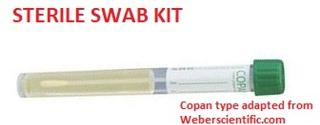 Sterile swab test kits are widely sold by online suppliers of environmental tests and other specialty suppliers. Below we'll list some swab test kit manufacturers or large suppliers.
Sterile swab test kits are widely sold by online suppliers of environmental tests and other specialty suppliers. Below we'll list some swab test kit manufacturers or large suppliers.
The sterile swab is normally a synthetic fibre such as rayon, not cotton. Sterile swab test kits are provided in a sterile container in which a sponge has been pre-moistened with a sterile solution.
For bacterial swab tests such as a test for sewage contaminants the wetting agent might be 1.5ml of phosphate-buffered saline (PBS) at the required pH of 7.2. That solution preserves and stabilizes the sample.
Watch out: using a swab test kit to screen for mold has significant deficiencies and is not a procedure we recommend. Swabbing destroys physical particles that might be used for direct microscopic identification of mold, and use of a swab to culture mold, while suitable for some medical procedures, is not reliable as a building contamination screen.
See MOLD CULTURE TEST KIT VALIDITY for details.
- CHAIN OF CUSTODY FORM for ENVIRONMENTAL SAMPLES [web page]
- CHAIN of CUSTODY FORM- Single Sample - Printer Friendly - PDF document version of the web page form just below
- CHAIN of CUSTODY FORM - Multiple Sample - Printer Friendly - PDF document for multiple samples
- Copan Diagnostic Swabs, [recommended] Copan Diagnostics, 26055 Jefferson Avenue | Murrieta, CA 92562 USA, Email: marketing@copanusa.net Tel: (800) 216-4016Website: http://www.copanusa.com/
- EMLab P&K swab kits [recommended], EMLab, 1501 W. Knudsen Drive, Phoenix, AZ 85027 USA, Tel 888.836.5227 Email: products@emlabpk.com Website: https://www.emlab.com
- Merck Millipore Sigma swabs & dips, MilliporeSigma Headquarters 400 Summit Drive, Burlington Massachusetts 01803 USA tel: 1-800-MILLIPORE (+1 800-645-5476), Website: http://www.emdmillipore.com/
- Path-Chek Hygiene surface swabs, Microbiology International, 5350 Partners Ct., Frederick MD 21703 USA, Tel: (800)396-4276 Website: https://800ezmicro.com
- Thomas Scientific, Swab tubes & BD BD Falcon Swab Screw Cap/Cotton Tip Applicators, & many other brands and versions, Thomas Scientific P.O. Box 99, Swedesboro, NJ 08085 USA, Tel: 800.345.2100, Website: https://www.thomassci.com
- Weber Scientific, Copan sterile swab kits, [recommended and shown earlier on this page], Weber Scientific
2732 Kuser Road
Hamilton, NJ 08691 Email:
info@weberscientific.com Tel: 800-328-8378 Website: https://www.weberscientific.com - Zefon International, "Mold Swab Test Kit", sterile surface swabs, Zefon International, Zefon International, Inc., 5350 SW 1st Lane, Ocala, FL 34474 USA Tel: 1-800- 282-0073, EMail: ZefonCS@zefon.com Website: http://www.zefon.com/
InspectAPedia.com is an independent publisher of building, environmental, and forensic inspection, diagnosis, and repair information provided free to the public - we have no business nor financial connection with any manufacturer or service provider discussed at our website. We do not sell products nor services.
...
Continue reading at SWAB & PCR SAMPLING & TESTS for MOLD or select a topic from the closely-related articles below, or see the complete ARTICLE INDEX.
Or see these
Recommended Articles
- ACCURACY OF AIR TESTS for MOLD
- DUST / MOLD TEST KIT INSTRUCTIONS
- ENVIRONMENTAL HAZARDS - INSPECT, TEST, REMEDY - home
- MOLD / ENVIRONMENTAL EXPERT, HIRE ? - when should you hire an onsite investigator?
- TEST KIT for DUST, MOLD, PARTICLES: INSTRUCTIONS
- SEWAGE BACKUP, WHAT TO DO
- BLOOD in ART WORKS, TESTING FOR
- MOLD CULTURE TEST KIT VALIDITY
- PESTICIDE EXPOSURE HAZARDS
- SWAB & PCR SAMPLING & TESTS for MOLD
- SWAB TEST KIT PROCEDURE
Suggested citation for this web page
SWAB TEST KIT PROCEDURE at InspectApedia.com - online encyclopedia of building & environmental inspection, testing, diagnosis, repair, & problem prevention advice.
Or see this
INDEX to RELATED ARTICLES: ARTICLE INDEX to DRAIN SEPTIC SEWER PIPES
Or use the SEARCH BOX found below to Ask a Question or Search InspectApedia
Ask a Question or Search InspectApedia
Try the search box just below, or if you prefer, post a question or comment in the Comments box below and we will respond promptly.
Search the InspectApedia website
Note: appearance of your Comment below may be delayed: if your comment contains an image, photograph, web link, or text that looks to the software as if it might be a web link, your posting will appear after it has been approved by a moderator. Apologies for the delay.
Only one image can be added per comment but you can post as many comments, and therefore images, as you like.
You will not receive a notification when a response to your question has been posted.
Please bookmark this page to make it easy for you to check back for our response.
IF above you see "Comment Form is loading comments..." then COMMENT BOX - countable.ca / bawkbox.com IS NOT WORKING.
In any case you are welcome to send an email directly to us at InspectApedia.com at editor@inspectApedia.com
We'll reply to you directly. Please help us help you by noting, in your email, the URL of the InspectApedia page where you wanted to comment.
Citations & References
In addition to any citations in the article above, a full list is available on request.
- Benson, A., ed. (1990) Control of Communicable Diseases in Humans, American Public Health Association, Washington, DC.
- Berry, M.A. (1993) Protecting the Built Environment: Cleaning for Health, Tricomm 21st press, Chapel Hill, NC, p. 185.
- Block, S.S. (1991) Disinfection, Sterilization, and Preservation, Lea & Febiger, Philadelphia, PA.
- Rogers, S.A. (1991) Indoor fungi as part of the cause of recalcitrant symptoms of the tight building syndrome. Env. International. 17:271-275.
- Clark, C.S. (1987) Potential and actual biological related health risks of waste water industry employment. J. Water Pollution Control. Fed. 59:12999-1008.
- Cole, E.C. (1989) Remedial measures for biological pollutants in the home. Workshop on Biological Pollutants in the Home. U.S. Consumer Product Safety Commission, American Lung Association. Microbiology, 31(3), 453-454.
- In addition to citations & references found in this article, see the research citations given at the end of the related articles found at our suggested
CONTINUE READING or RECOMMENDED ARTICLES.
- Carson, Dunlop & Associates Ltd., 120 Carlton Street Suite 407, Toronto ON M5A 4K2. Tel: (416) 964-9415 1-800-268-7070 Email: info@carsondunlop.com. Alan Carson is a past president of ASHI, the American Society of Home Inspectors.
Thanks to Alan Carson and Bob Dunlop, for permission for InspectAPedia to use text excerpts from The HOME REFERENCE BOOK - the Encyclopedia of Homes and to use illustrations from The ILLUSTRATED HOME .
Carson Dunlop Associates provides extensive home inspection education and report writing material. In gratitude we provide links to tsome Carson Dunlop Associates products and services.


